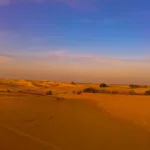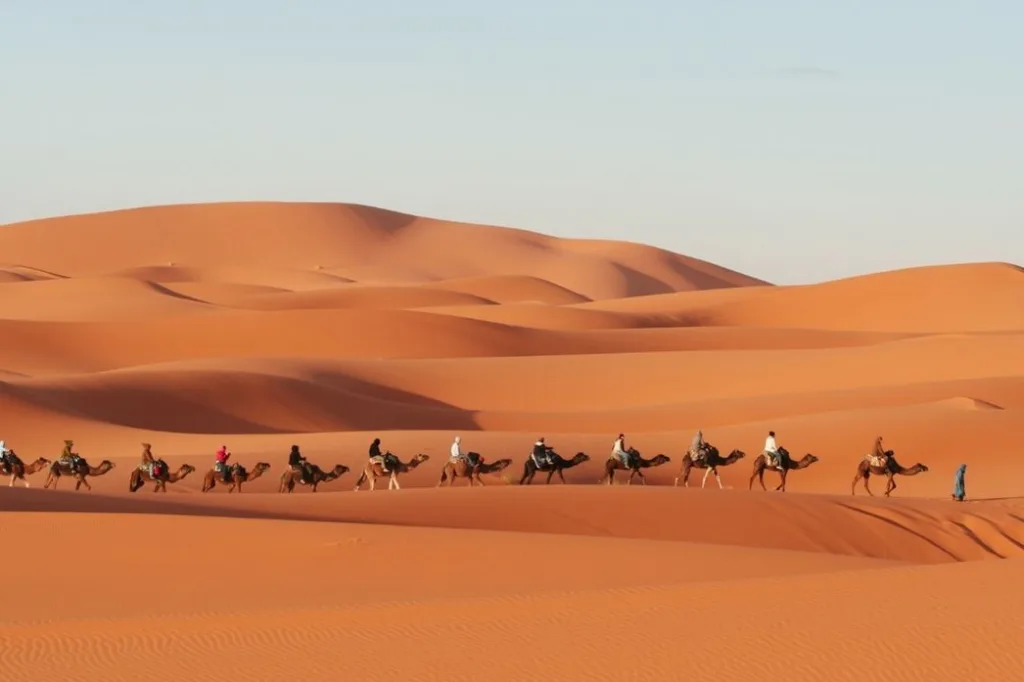Location & Continent
Continent: Africa
Country: Senegal
Coordinates: 15°55′N, 16°40′W
Photos of the Lompoul Desert
Physical Features
Area: ~18 km² (small desert)
Elevation: Mostly low-lying coastal dunes
Notable Landforms: Orange sand dunes rising up to 40–50 m
Climate & Precipitation
Temperature: Warm year-round; daytime averages 25–35°C
Precipitation: 300–400 mm annually; semi-arid climate influenced by Atlantic Ocean
Ecological Features
Ecozone: West African coastal Sahel
Biome: Semi-arid desert and xeric shrubland
Ecoregions: Sahelian Acacia Savanna
Flora & Fauna
Flora: Sparse grasses, acacia shrubs, desert-adapted plants
Fauna: Small reptiles, desert rodents, migratory birds
Geology & Notable Features
Geology: Coastal sand formations shaped by wind from the Atlantic
Notable Features: Popular for eco-tourism, camel rides, and the annual Festival du Sahel music event
Introduction
The Lompoul Desert, nestled in Senegal, is a captivating region that offers a unique blend of landscapes, culture, and adventure. This relatively undiscovered desert is an enigmatic destination that attracts both travelers seeking solitude and those looking for unforgettable experiences. In this article, we will dive into the geography, climate, wildlife, and cultural significance of the Lompoul Desert, highlighting what makes it a remarkable place to visit.
Geography
The Lompoul Desert is characterized by its shifting sand dunes, which can reach heights of up to 30 meters. Spanning approximately 42 km², this desert features a series of stunning landscapes, including golden sands and vast plateaus. It is located only a short distance from the vibrant coastline of Saint-Louis, making it accessible for visitors exploring the area.
Topographical Features
The desert’s terrain is primarily composed of fine sand, dotted with occasional patches of resilient vegetation like acacia trees. The dunes are shaped and reshaped regularly by winds, creating dynamic forms that change with the seasons. This geographical feature sets Lompoul apart from other more arid deserts, offering a picturesque view ideal for photography enthusiasts.
Climate
The climate in Lompoul is classified as a semi-arid desert climate, characterized by high temperatures and low rainfall. Typically, daytime temperatures can soar to 40°C (104°F) during the summer months, while nighttime temperatures can dramatically drop to around 15°C (59°F).
Rainfall Patterns
Rainfall in the Lompoul Desert is limited, averaging 150 to 300 millimeters annually. Most of the precipitation occurs during the rainy season from July to September when the desert’s landscape comes alive with a burst of colors that transform the yellow sands to vibrant greens and browns. This seasonal change draws migratory birds and animals into the area.
Flora and Fauna
Despite its arid conditions, the Lompoul Desert boasts a surprisingly diverse ecosystem. Adapted to the harsh climate, various species of flora and fauna thrive in this unique environment. Vegetation includes hardy plants such as cacti and spiny shrubs.
Wildlife
The Lompoul Desert is home to several species of animals, including:
| Animal Species | Habitat | Status |
|---|---|---|
| Fennec Fox | Sand Dunes | Least Concern |
| Addax Antelope | Sparse Vegetation | Critically Endangered |
| Desert Locust | Grasslands | Common |
Cultural Significance
The Lompoul Desert is not only a natural wonder but also a region steeped in cultural heritage. The local communities, primarily made up of the Wolof people, maintain traditional customs and practices that are intertwined with the desert’s identity.
Tourism and Activities
The desert has begun to attract tourists in search of adventure. Popular activities include:
- Sandboarding: Thrilling rise on the golden dunes.
- Camel Trekking: Experience the vastness of the desert atop these gentle giants.
- Stargazing: With minimal light pollution, the night sky is a canvas of stars.
Conclusion
The Lompoul Desert is a hidden gem within Senegal, offering a captivating landscape and rich cultural experiences. From its stunning topographical features to diverse wildlife, the desert is both a natural wonder and a crucial part of the local community’s identity. For adventure seekers and culturally curious travelers alike, Lompoul provides an unforgettable experience framed in the warmth of the Senegalese sun.





